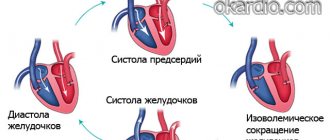Adrenocorticotropic hormone, or ACTH, is a hormone produced by the pituitary gland, a small gland at the base of the brain. It stimulates the secretion of steroid hormones in the adrenal cortex, two small glands located above the kidneys. Its main effect is to increase the production of the hormone cortisol by the adrenal glands.
Cortisol plays an important role in helping to: respond to stress; fight infection; regulate blood sugar levels; maintain blood pressure; regulate metabolism - the use of food and energy. Too much or too little cortisol can cause serious health problems.
Adrenocorticotropic hormone is used as a medicine and diagnostic agent. ACTH is an important component of the hypothalamic-pituitary-adrenal axis and is often produced by the body in response to biological stress.
What is adrenocorticotropic hormone? Chemical structure and synthesis
The content of the article
Adrenocorticotropic hormone or ACTH is a polypeptide with a molecular weight of 5250, consisting of 39 amino acid residues in a single chain, without disulfide cross-links. Its biological activity is manifested in the sequence of the first 24 N-terminal amino acid residues, and this sequence is identical in all species studied.
Adrenocorticotropic hormone is produced by corticotropic cells of the anterior pituitary gland. ACTH is secreted in response to the release of corticotropin releasing hormone or CRH from the hypothalamus. The effect of CRH on ACTH release is enhanced by another hypothalamic hormone, vasopressin. ACTH production and secretion are regulated by glucocorticoid feedback, with ACTH being at the center of a homeostatic network involving the hypothalamus and pituitary gland.
It is secreted throughout the day in several intermittent pulses and transported by the blood throughout the body. Like cortisol, adrenocorticotropic hormone levels are typically highest in the morning upon waking and lowest during sleep. This is called the daily or circadian rhythm.
The synthesis, storage, and release of ACTH by the pituitary gland is influenced by stress, circulating corticosteroid levels, and a 24-hour cyclic rhythm that responds slowly to day/night cycles and sleep patterns. All of these regulatory effects are thought to be mediated by hypothalamic corticotropin releasing factor, or CRF. ACTH levels are also affected by sleep, exercise, and pregnancy.
ACTH production can occur in four main classes of tumors: bronchial carcinoma, ovarian carcinoma, pheochromocytoma, and endocrine foregut tumors such as bronchial or thymic carcinoid, medullary thyroid carcinoma, and pancreatic islet tumors.
What is adrenaline?
Adrenaline is a substance that is produced in the adrenal medulla, as well as in some neurons of the central nervous system. Within a few minutes during a stressful situation, adrenaline is quickly released into the blood, sending impulses to the organs to create a specific reaction.
Adrenaline is usually released when we are in a stressful situation; it is said to govern our fight-or-flight conditions. When we encounter a situation that causes us stress, this hormone rushes to certain parts of our body, causing us to react, this is called the release of adrenaline. For example, a dry throat during public speaking or a rapid heartbeat in a frightening situation are all due to the release of the hormone adrenaline. As stress gradually subsides, its effects are neutralized by norepinephrine, a body hormone.
Functions of adrenocorticotropic hormone
- Adrenocorticotropic hormone reaches the adrenal glands and binds to receptors, causing the adrenal glands to secrete more cortisol, which leads to higher levels of cortisol in the blood. It also increases the production of chemical compounds that cause an increase in the levels of other hormones - adrenaline and norepinephrine.
- ACTH stimulates the synthesis and release of cortisol within 2 to 3 minutes, increasing the formation of free cholesterol, as a consequence of increased cholesterol and decreased cholesterol esters.
- ACTH accelerates the transport of cholesterol across mitochondrial membranes, promotes the binding of cholesterol to cytochrome P450scc and the release of newly synthesized pregnenolone from mitochondria.
- ACTH stimulates the release of adrenal mineralocorticoids and androgens, as well as the release of various intermediates.
- The chronic action of ACTH affects both the structure of the adrenal glands and steroidogenesis. ACTH continuously stimulates the uptake and metabolism of low-density lipoprotein or LDL, the synthesis of the LDL receptor and other factors. Therefore, it has a stimulating effect on all known early stages of steroidogenesis.
- The persistent effects of ACTH on steroidogenesis arise mainly through stimulation of the transcription of genes encoding steroidogenic enzymes and other factors. ACTH increases transcription of the P450scc, P450c17, P450c21, and P450c11 genes and stimulates human P450scc mRNA accumulation and human P450scc activity. The exact mechanisms of ACTH stimulation of the side chain cleavage enzyme P450scc are not yet known.
- ACTH promotes both adrenal cell hypertrophy and hyperplasia. ACTH in physiological concentrations can promote the synthesis of insulin-like growth factor-II or IGF-II, the synthesis of basic fibroblast growth factor and epidermal growth factor, which act together with IGF-II to stimulate adrenal growth.
- ACTH plays a role in glucose metabolism and immune function.
Find something you like
Learning to relax is really helpful, especially if you want to manage stress. Taking up a new hobby is one way that can also help you learn a new skill. It doesn't matter what you do, as long as you enjoy it.
Photo by Steve Johnson / Unsplash
American scientists conducted a study of 50 former combatants who suffered from depression, post-traumatic stress disorder or substance abuse. They spent a month doing gardening and occupational therapy. The results showed a decrease in stress and a decrease in cortisol.
Think about what kind of activity you would like - perhaps drawing, music or gardening.
Mechanism of action of ACTH
CRH is released from the hypothalamus. CRH stimulates the release of ACTH from the anterior pituitary gland. ACTH acts on the adrenal cortex, releasing cortisol and androgens. Increased cortisol levels provide a negative feedback system to reduce the amount of CRH released from the hypothalamus.
ACTH acts on G protein-coupled receptors on the extracellular membranes of the fascicular and reticular zones of the adrenal cortex. cAMP is a secondary messaging system. Activation of the g-pair receptor activates adenylate cyclase, thereby increasing cAMP production.
The circadian rhythm influences the secretion of cortisol. Cortisol levels are highest in the early morning and lowest in the evening. This concept is important for diagnostic testing.
Pay attention to the quality of your sleep
It is easier for a person who has had a good night's sleep to cope with the effects of stress and unpleasant situations. The quality and duration of your sleep depends largely on your circadian rhythms and habits. What time you go to bed and wake up also plays a role. Research shows that people who work night shifts and sleep during the day are more likely to have elevated cortisol levels.
How to fix your biological clock so you can sleep well and get enough sleep
Shift work before age 40 is associated with higher body mass index (BMI) and higher cortisol levels.
Cortisol may be elevated due to lack of sleep or insomnia, especially in the evening after lack of sleep. The hypothalamic-pituitary-adrenal system is responsible for the production of cortisol. When a threat to the body appears, the hypothalamus part of the brain synthesizes special substances that are sent to the pituitary gland. This in turn sends a signal to the adrenal glands. In response, the adrenal cortex produces cortisol, some of which returns to the brain, affecting thinking processes. This relationship between the brain and the kidneys is called the hypothalamic-pituitary-adrenal axis.
The hypothalamic-pituitary-adrenal axis is also responsible for regulating sleep cycles. The axis can be activated by stress, illness or poor nutrition. This can subsequently impair your sleep and increase cortisol.
Sleep hygiene is one of the decisive factors in its quality. Try to create conditions in which the amount of noise and light is minimal. Thick curtains, an eye mask, and earplugs will help with this. We wrote about this in detail in this article.
6 ways to improve your sleep patterns and overcome insomnia
Tips for improving sleep quality to reduce cortisol levels:
- Try to go to bed and wake up at the same time
- Wash bedding and sleepwear regularly - a fresh smell helps the body relax
- Try not to use devices that emit blue light (TV, phone, tablet) 2-3 hours before bedtime
- Avoid caffeinated drinks in the afternoon
- Avoid excessive strength and cardio exercises two hours before bed.
How is the production of adrenocorticotropic hormone controlled?
The secretion of adrenocorticotropic hormone is controlled by three interconnected areas of the body:
- hypothalamus;
- pituitary gland;
- adrenal glands.
This is called the hypothalamic-pituitary-adrenal axis, or HPA. When cortisol levels in the blood are low, a group of cells in the hypothalamus releases a hormone called corticotropin-releasing hormone, or CRH. It stimulates the pituitary gland to secrete adrenocorticotropic hormone into the bloodstream.
High levels of adrenocorticotropic hormone are determined by adrenal receptors. This stimulates the secretion of cortisol, causing an increase in its levels in the blood. As cortisol levels rise, the release of corticotropin-releasing hormone from the hypothalamus and adrenocorticotropic hormone from the pituitary gland begins to decrease. As a result, the level of adrenocorticotropic hormone and, as a result, cortisol begins to fall. This is called a negative feedback loop.
Stress, both physical and psychological, stimulates the production of adrenocorticotropic hormones and therefore increases cortisol levels.
Diagnostics and treatment of stress hormones at Altimed MC
To find out what caused the increase in hormones, it is necessary to undergo a complete diagnosis of the body. This can be done quickly and painlessly here at Altimed MC. We use our own equipment for a complete diagnosis of the body.
Functional screening helps measure stress-related cortisol levels , as well as vitamin and mineral levels. With its help, you can get a complete picture of the functioning of the entire organism.
ATM Vega Test reveals hidden diseases, helps determine their severity and understand what caused them. Based on the results obtained, our specialists can create an effective treatment plan, the results of which you will notice in the first days.
What is cortisol? Chemical structure and synthesis
Cortisol is a steroid hormone synthesized in the adrenal cortex from cholesterol. Cortisol is a derivative of isopentenyl pyrophosphate or IPP.
Cortisol synthesis
Pregnenolone, a common precursor of steroid hormones such as cortisol, is synthesized in the mitochondria of the adrenal cortex. The enzyme that catalyzes the formation of pregnenolone through the 20α-dihydroxycholesterol intermediate is called cholesterol desmolase and is a monooxygenase. It contains NADPH as a cofactor. It requires heme-containing cytochrome P450 as a coenzyme.
However, the main substance in the biosynthesis of cortisol is not cholesterol desmolase, but cholesterol translocase, located on the outer membrane of mitochondria. It transports essential cholesterol to the inner mitochondrial membrane. This protein, known as the “StAR protein,” is an acutely regulated steroidogenic protein.
The synthesis of pregnenolone begins with cholesterol. Pregnenolone leaves the mitochondria and is converted to progesterone by 3β-hydroxysteroid dehydrogenase. In the endoplasmic reticulum, this progesterone is converted to 17α-hydroxyprogesterone by the enzyme 17-steroid hydroxylase.
Further hydroxylation catalyzed by 21-hydroxylase produces 11-deoxycortisol. It is converted to cortisol in the mitochondria by the steroid 11beta-hydroxylase.
The formation of cortisol in the fascicular zone of the adrenal cortex is stimulated by adrenocorticotropic hormone or ACTH from the pituitary gland.
Communicate with animals
It has been scientifically proven that contact with animals is associated with reduced cortisol levels. Scientists have studied how interaction with animals affects stress, and found that long-term interaction with dogs, even strangers, as well as owning a pet, have a positive effect on cortisol levels. In addition, the interaction between a person and a dog increases the level of oxytocin in both.
Photo by Vitalie Sitnic / Unsplash
Having pets is associated not only with reduced stress levels, but also with other health benefits. It is easier for owners of cats, dogs, parrots and other pets to focus their attention. Animals also have a positive effect on blood pressure and help avoid feelings of loneliness.
Physiological effect
Cortisol activates catabolic metabolic processes and provides the body with high-energy compounds.
Cortisol has a broad spectrum of action and has metabolic effects on:
- carbohydrate balance – promotes gluconeogenesis in the liver;
- lipid metabolism – promotes the lipolytic effect of adrenaline and norepinephrine;
- protein metabolism is catabolic.
Cortisol delays the excretion of water and has an anti-inflammatory effect.
Cortisol is involved in regulating human growth.
The goal of metabolic activation through cortisol is to increase the body's available energy so it can better withstand one-time or repeated physical and psychological stress. Thus, cortisol is closely related to physical and mental stress and can be considered the most important stress hormone.
Because, under the influence of cortisol:
- body temperature rises;
- energy metabolism is activated;
- pain reactions are suppressed.
What is adrenaline stress
Adrenaline release occurs at the moment of maximum tension. It is noteworthy that this process can be triggered by both ordinary viewing of a horror film and serious stressful situations. An excess of stress hormones negatively affects the general condition of the body and can lead to the development of chronic stress.
Adrenaline stress to a state in which the maximum release of a hormone occurs under the influence of any situation. At this moment, a person’s strength doubles, and he is able to solve a problem of any complexity. But if adrenaline during stress is the norm, then its excess in a calm state is a real danger to the body. A person may develop the following pathologies:
- high blood pressure;
- severe headaches;
- nausea;
- sleep problems.
In its classic form, the stress hormone adrenaline enhances the body's protective functions. But an abnormal excess can cause diseases of the cardiovascular system. Increased levels of adrenaline lead to the accumulation of fat and sugar in the blood, which leads to excessive weight gain.
In some cases, a person develops adrenaline addiction, and as it develops, the following occurs:
- increased heart rate;
- rapid breathing;
- dilated pupils;
- increase in pressure.
Regularly experiencing adrenaline stress is dangerous to your health!
Overall, cortisol and adrenaline perform many important tasks in the body. For example, in stressful situations they prepare you to be at the top of your game. Hormones also help the brain use glucose as an energy source. In short, cortisol improves your performance. When you need to perform well in a difficult situation, the stress hormones norepinephrine and adrenaline are first quickly released. This is followed by a release of cortisol. The combination of these hormones increases heart rate, blood pressure, and has many other effects. Essentially, cortisol activates you in challenging situations. Read on to learn how to lower cortisol.
Why do you need an ACTH and cortisol test?
This test may be needed if a patient has symptoms of too much or too little cortisol.
Symptoms of high cortisol levels:
- weight gain;
- accumulation of fat in the shoulders;
- pink or purple stretch marks on your stomach, thighs, and chest;
- easily appearing bruises on the skin;
- increase in body hair;
- muscle weakness;
- fatigue;
- acne.
Symptoms of low cortisol levels:
- weight loss;
- nausea and vomiting;
- diarrhea;
- abdominal pain;
- dizziness;
- darkening of the skin;
- craving for salty foods;
- fatigue.
This test may be needed if the patient has symptoms of hypopituitarism. Symptoms will vary depending on the severity of the disease, but may include the following:
- loss of appetite;
- irregular menstruation and infertility in women;
- hair loss on the body and face in men;
- decreased libido in men and women;
- sensitivity to cold;
- frequent urination;
- fatigue.
Complexes with this research
Advanced anti-aging diagnostics in postmenopause Advanced monitoring of age-related changes during postmenopause 29,230 ₽ Composition
Adrenogenital complex Analysis of excess male hormones in a woman 2,560 ₽ Composition
Advanced male anti-aging diagnostics Advanced monitoring of key indicators in men aged 40+ RUB 33,710 Composition
IN OTHER COMPLEXES
- Advanced women's anti-aging diagnostics RUB 28,680
- Female infertility RUB 16,210
- Three important indicators for a man RUB 1,810
- Metabolic profile RUB 5,900
- Male anti-aging diagnostics RUB 13,300
Preparation for analysis, test procedure and its risks
It is recommended to fast overnight before testing. Tests are usually done early in the morning because hormone levels change throughout the day.
What happens during an ACTH test?
The healthcare professional will take a blood sample from a vein in your arm using a small needle. Once the needle is inserted, a small amount of blood will be collected in a tube. A slight tingling sensation may occur as the needle is inserted and removed. The procedure usually takes less than five minutes.
Are there any risks to the test?
The risk of having a blood test is very low. There may be some mild pain or bruising where the needle was inserted, but most symptoms go away quickly.
Identify stress triggers
A threat to life or a change in environment are stimuli that provoke anxiety and can become a trigger or stressor. Such irritants include physical pain, problems in relationships or at work, and financial difficulties. It is, of course, impossible to predict when you will hit your foot on a chair. But some types of triggers can be learned to recognize.
5 reasons why health and well-being depend on love
One of the first steps to relieve stress is to understand what causes it. I don’t want to remember or think about unpleasant situations again. But a stress diary will help you recognize irritants so you can learn to react less to them. It is not necessary to remember all the details of an unpleasant event - it is enough to write down the fact and try to analyze why what happened caused you a negative reaction.
Using a stress diary can help you find practical ways to deal with these situations. For example, avoid quarrels, learn to build personal boundaries in relationships and at work, and say “no” in time. Moreover, you will be able to identify hidden causes of stress such as hanging on social networks.









